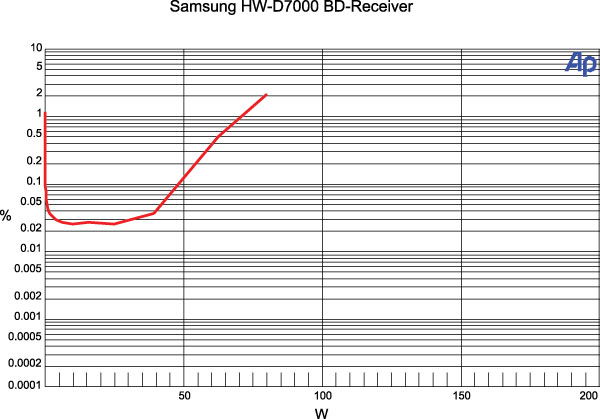Samsung HW-D7000 BD-Receiver HT Labs Measures
Five channels driven continuously into 8-ohm loads:
0.1% distortion at 36.1 watts
1% distortion at 43.5 watts
Seven channels driven continuously into 8-ohm loads:
0.1% distortion at 32.7 watts
1% distortion at 35.9 watts
Analog frequency response in S. Direct mode:
–0.10 dB at 10 Hz
–0.03 dB at 20 Hz
+0.50 dB at 20 kHz
–59.13 dB at 50 kHz
Analog frequency response with stereo signal processing:
–0.11 dB at 10 Hz
–0.03 dB at 20 Hz
+0.49 dB at 20 kHz
–59.56 dB at 50 kHz

This graph shows that the HW-D7000’s left channel, from TV input to speaker output with two channels driving 8-ohm loads, reaches 0.1 percent distortion at 48.1 watts and 1 percent distortion at 70.8 watts. Into 4 ohms, the amplifier reaches 0.1 percent distortion at 89.5 watts and 1 percent distortion at 130.8 watts.
There was no multichannel input to measure. THD+N from the TV input to the speaker output was less than 0.045 percent at 1 kilohertz when driving 2.83 volts into an 8-ohm load. Crosstalk at 1 kHz driving 2.83 volts into an 8-ohm load was –88.15 decibels left to right and –88.01 dB right to left. The signal-to-noise ratio with an 8-ohm load from 10 hertz to 24 kHz with “A” weighting was –88.06 dBrA.
From the Dolby Digital input to the loudspeaker output, the left channel measures –0.00 dB at 20 Hz and +0.65 dB at 20 kHz. The center channel measures –0.00 dB at 20 Hz and +0.56 dB at 20 kHz, and the left surround channel measures –0.00 dB at 20 Hz and +0.67 dB at 20 kHz. From the Dolby Digital input to the line-level output, the LFE channel is +0.02 dB at 20 Hz when referenced to the level at 40 Hz and reaches the upper 3-dB down point at 117 Hz and the upper 6-dB down point at 120 Hz.—MJP
Editor’s Note: Mark Fleischmann’s good experience notwithstanding, readers should know we required three samples of the HW-D7000 to finish our evaluation. Mark’s original review unit was dead on arrival at our test lab after its cross-country travel, and a replacement from Samsung failed immediately, complete with a loud pop and the scent of burnt circuitry, upon being plugged into AC power. A third unit from Samsung was used to conduct the audio measurements you see here and our Video Test Bench tests.
Video Test Bench
From an HDMI input to an HDMI output, the Samsung can upconvert (deinterlace and/or scale) from its built-in Blu-ray player. However, with an external source (such as an outboard video disc player or a cable/satellite receiver), it’s a straight passthrough (480i in = 480i out, 1080i in = 1080i out, etc.) regardless of the setting of the setup menu’s output Resolution control. All of our digital tests were performed using the internal player, but since there are no 480p Blu-ray Discs, much less any with appropriate test patterns, our scaling test is not applicable here. (This test is normally performed from a 480p input to a 1080p output, which we obtain by upconverting our 480i test pattern to 480p using an external player known to have reliable deinterlacing performance.)
The Samsung disc player also balked more than usual in playing back the stationary test patterns on the Spears & Munsil High Definition Benchmark test disc, but I finally got it to work long enough to run the tests. This disc has hiccupped intermittently on other players as well, but it did so more here than ever before.
The results of the digital tests were middling at best, but experience suggests that this doesn’t mean that real-world images will be unsatisfactory. However, you may see occasional artifacts with some sorts of program material, artifacts that will be less annoying here than they would be on a pricier, high-end AVR. I confirmed that the Samsung’s internal player will reproduce 3D Blu-ray Discs properly.

The situation was different for our analog tests. Here we crossconvert a component input to an HDMI output and must run the tests with an external source. But the AVR’s component input responds only to a 480i input, which it will upconvert to whatever resolution you’ve chosen, including 1080p. However, if you feed it a source of any other resolution, including any flavor of HD, you’ll get no output at all. All of our tests apart from three involve 1080i, 1080p, or 480p. Therefore, the only applicable tests here were 3:2 SD, 2:2 SD, and MA SD, all of which involve converting 480i in to 1080p out and all of which the Samsung passed.
Incidentally, to use the receiver’s component in to HDMI out capability, you can use only the Sat component input. You must also use the Audio Assign button on either the remote or front panel to select Sat Analog or Sat Optical to get the picture. I couldn’t locate this nonintuitive procedure anywhere in the manual (although that doesn’t mean it isn’t there, staring me in the face) but rather had to contact Samsung’s tech support for it.—TJN





























































